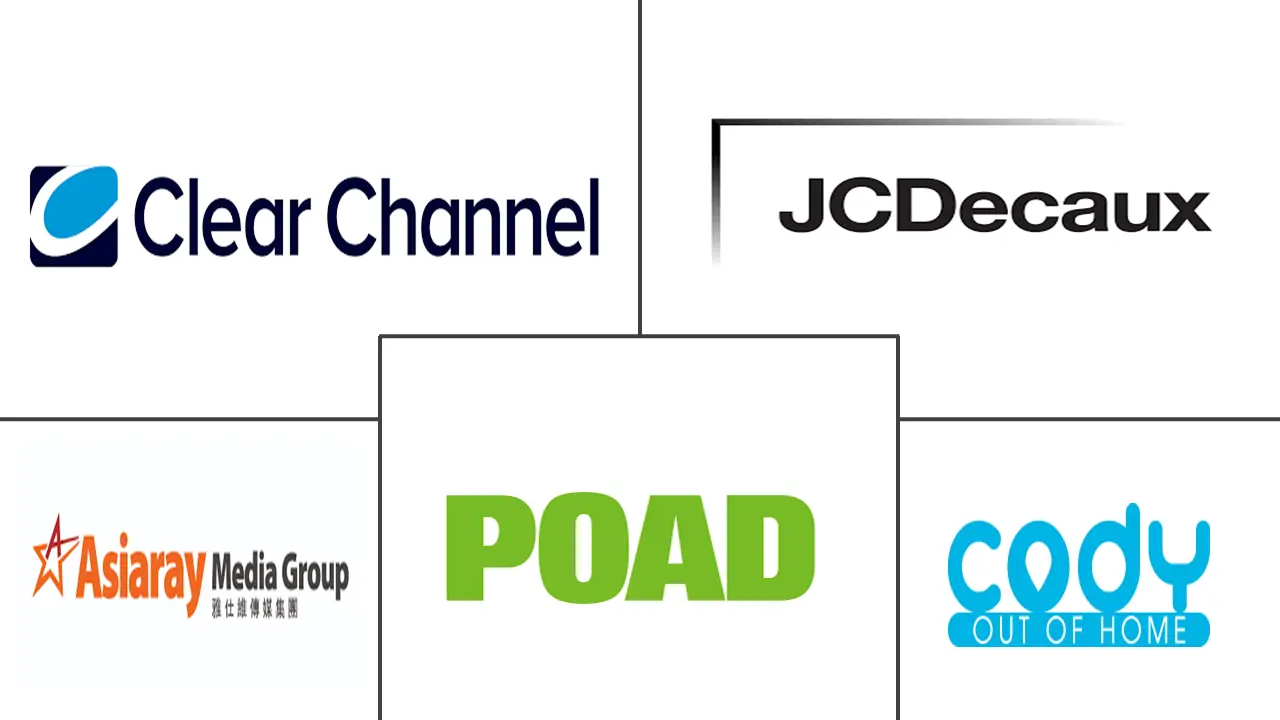Hong Kong OOH And DOOH Market Size and Share
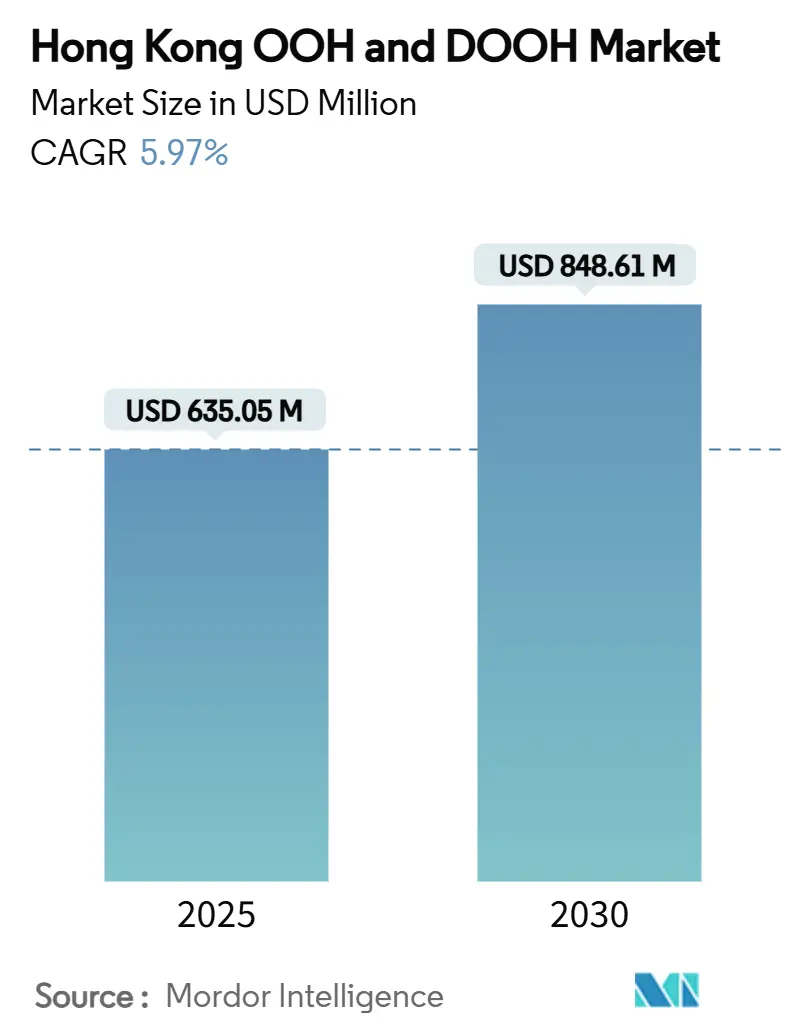
Hong Kong OOH And DOOH Market Analysis by Mordor Intelligence
The Hong Kong OOH and DOOH advertising market size is estimated at USD 635.05 million in 2025 and is forecast to reach USD 848.61 million by 2030, registering a 5.97% CAGR through the period. Digital OOH commands 57.8% share of spend, reflecting advertisers’ rising preference for flexible, data-driven screens that can update creative in real time. Programmatic DOOH is the standout high-velocity pocket, set to expand at 9.2% CAGR to 2030, as automated buying unlocks granular audience targeting across Hong Kong’s transit, retail, and street-level networks. Transit formats—covering airports, MTR, buses, and ferries—retain a 40.2% slice of revenue, while airport media alone is projected to grow 8.1% annually on the back of resurgent visitor flows. Mainland Chinese tourist traffic remains a core demand driver, even as younger travelers adopt “special-forces-style” itineraries that shorten stays and concentrate spend in fewer locations. Against this growth narrative, stringent signage height limits, heritage protections on Hong Kong Island, and fragmented building-facade ownership constrict new inventory, intensifying competition for premium spots and nudging advertisers toward high-impact digital units that deliver scale within tighter footprints.
Key Report Takeaways
- By type, digital OOH led with 57.8% share of 2024 revenue, while programmatic DOOH is forecast to post a 9.2% CAGR to 2030.
- By format, transit environments accounted for 40.2% of the Hong Kong OOH and DOOH advertising market size in 2024; airport media is projected to expand at an 8.1% CAGR through 2030.
- By location environment, outdoor screens captured 72.5% of spend in 2024, whereas indoor media is advancing at a 6.9% CAGR between 2025-2030.
- By end-user industry, retail and consumer goods commanded 30.4% of the Hong Kong OOH and DOOH advertising market share in 2024, while healthcare and pharmaceuticals represent the fastest-growing vertical with an 8.5% CAGR outlook.
- By company concentration, JCDecaux, Asiaray and POAD collectively controlled just over 45% of booked inventory value in 2024, leaving meaningful white space for specialist local operators to scale.
Hong Kong OOH And DOOH Market Trends and Insights
Drivers Impact Analysis
| Driver | (~) % Impact on CAGR Forecast | Geographic Relevance | Impact Timeline |
|---|---|---|---|
| Digitisation of MTR & airport media | +1.80% | Territory-wide transit hubs | Medium term (2-4 years) |
| Surge in cross-border mainland tourist flow | +1.20% | Tourist corridors (TST, Causeway Bay, Central) | Short term (≤2 years) |
| Government smart-city street furniture | +0.90% | Pilot districts (Kwun Tong, Central & Western, Tsuen Wan) | Medium term (2-4 years) |
| Retail-as-media expansion in malls | +1.50% | Premium malls (Central, Kowloon, New Territories flagships) | Medium term (2-4 years) |
| Source: Mordor Intelligence | |||
Digitisation of MTR & Airport Media Networks
Hong Kong’s transit operators are rapidly converting static panels into connected screens that synchronize with real-time passenger data. MTR Corporation’s 99-station grid already delivers full-motion creative to millions of daily riders, and forthcoming Northern Link construction will unlock fresh screen clusters in the New Territories. At Hong Kong International Airport, Hitachi Rail’s February 2025 deployment of 5G digital signaling aboard the Automatic People Mover pipes anonymized rider counts and dwell-time metrics directly into ad-server dashboards, letting brands swap creatives on the fly when flight banks shift or demographics change.[1]Hitachi Rail, “Hitachi Rail Delivers 5G Train-to-Ground Communications for Hong Kong International Airport APM,” hitachi.com JCDecaux and Asiaray use these live dashboards to guarantee minimum-impression packages, reducing perceived waste and supporting premium CPMs. As the Airport Authority relaunches In-Town Check-in for Cathay Pacific, additional check-in kiosks and baggage belts are being kitted with dynamic lightboxes, extending dwell zones where travelers can absorb longer-form brand stories.[2]Hong Kong Extras, “Airport Express In-Town Check-in Returns for Cathay Pacific Passengers,” hongkongextras.com
Surge in Cross-Border Mainland Tourist Traffic Boosting CPMs
The Hong Kong Tourism Board expects 46 million arrivals in 2024—a 35% rebound versus 2023—of which 78% originate from mainland China. Younger visitors now organize short, spontaneous itineraries, spending an average of 3.2 nights, compared with 3.6 nights last year. Their preference for mobile discovery elevates digital screens positioned along MTR exits, ferry piers, and flagship retail corridors. Advertisers have lifted CPM bids for Cantonese-and-Mandarin creative packages in Tsim Sha Tsui by 18% year-on-year, chasing foot traffic to duty-free shopping zones. Government backing compounds demand: the 2024 budget reserves HKD 1.095 billion (USD 0.14 billion) for themed promotions such as TV reality shows and “Night Vibes Hong Kong” tours, widening co-op opportunities for brands to piggyback official campaigns.
Government-Backed Smart-City Initiatives Enabling Data-Rich Street Furniture
Under the Smart City Blueprint, lamp-posts, bus shelters, and traffic lights are being equipped with sensors, LED panels, and 5G micro-cells. The Office of the Government Chief Information Officer’s multifunctional lamp-post pilot now spans 400 units that capture pedestrian counts, temperature, and air-quality data every three seconds. Media owners overlay anonymized footfall data onto planning platforms, letting agencies optimize loop length and creative rotation to match rush-hour peaks. HKT’s edge-computing gateway streams this sensor feed into its addressable TV hub, opening the door to synchronized cross-screen campaigns where commuters see the same offer on a street kiosk and, later, on Now TV at home.
Retail-as-Media Trend Among Large Mall Operators Creating New Screens
Premium landlords are turning concourses into full-fledged media networks that couple first-party shopper data with immersive formats. Hongkong Land’s USD 1 billion refurbishment of LANDMARK adds 10 multi-storey “Maison” zones, each ringed with 8K ceiling-hung LEDs that can run wraparound brand takeovers. Link REIT’s 9.2 million sq ft Hong Kong retail portfolio posted 98% occupancy in FY 2023/24, enabling steady audience reach for digital escalator ribbons and interactive lift lobby screens. Because these landlords own both the data and the real estate, they can close the attribution loop by matching store-level sales to screen exposures, a capability drawing incremental budgets from FMCG and luxury advertisers.
Restraints Impact Analysis
| Restraint | (~) % Impact on CAGR Forecast | Geographic Relevance | Impact Timeline |
|---|---|---|---|
| Height and heritage limits on Hong Kong Island facades | –1.1% | Central, Sheung Wan, Wan Chai heritage grids | Long term (≥ 4 years) |
| Fragmented ownership of building skins | –0.8% | Territory-wide, acute in pre-1990 districts | Long term (≥ 4 years) |
| Rising digital-video competition for brand budgets | –0.7% | Territory-wide | Medium term (2-4 years) |
| Macroeconomic uncertainty and FX pressure | –0.5% | Export-dependent sectors city-wide | Short term (≤ 2 years) |
| Source: Mordor Intelligence | |||
Stringent Outdoor Signage Height & Heritage Restrictions on Hong Kong Island
The Planning Department’s Joint Practice Notes cap rooftop sign heights and enforce visual corridors that protect harbor panoramas. Simultaneously, monuments such as Tin Hau Temple place blanket bans on new signage within 100 m buffer zones Planning. Combined, these rules lock roughly 22% of prime island facades out of the market, driving scarcity premiums of 25-30% for compliant surfaces. Advertisers sidestep constraints by deploying high-luminance LEDs behind window glass, which qualify as indoor media even though they face the street. Yet power-consumption limits and curfew rules still apply, chipping away at operating margins for newcomers.
Fragmented Ownership of Building Facades Hampers Scale Buys
Unlike markets where a single landlord may control an entire block, a typical Hong Kong mid-rise is split among dozens of strata-title owners. Securing a single wrap can therefore require ten or more separate contracts, each with its own access schedule, insurance clause and revenue-share demand. Global brands gravitate to incumbents such as JCDecaux and POAD because they already hold master licences aggregating these fragments. Smaller media firms face protracted negotiations that delay campaign launches and inflate transaction costs, pulling dollars toward easily bookable digital networks instead.
Segment Analysis
By Type: Digital Dominates While Programmatic Accelerates
Digital OOH generated USD 350 million of the Hong Kong OOH and DOOH advertising market size in 2024 and is pacing for a 7.3% CAGR to 2030 as advertisers prioritize real-time creative control. Within this pool, programmatic trading layers add a forecast 9.2% CAGR, with JCDecaux’s VIOOH platform recording a 61.8% global revenue leap in H1 2024.[3]JCDecaux SE, “First Half 2024 Results,” jcdecaux.com Agencies leverage data-rich transit screens to retarget passengers across mobile DSPs, linking upper-funnel awareness to app installs. Static roadside billboards still anchor brand stature in heritage precincts where LED retrofits breach conservation rules, but statics’ share is eroding 80 bps a year. Hybrid packages that pair a landmark vinyl wrap with geofenced mobile ads are proving cost-efficient for luxury and financial clients courting cross-border shoppers.
Advertisers cite programmatic DOOH’s flexible day-part buying and PMP deal IDs as key advantages when testing alternative creative lines. Audience segments built with Vistar Media and Eyeota data now let planners bid only when mainland visitor impressions exceed a pre-set threshold, boosting targeting efficiency in peak Golden Week periods.[4]Mediaweek, “Eyeota Data Now Live in Vistar Media DSP,” mediaweek.com.au Compliance checks remain tight: all programmatic loops must submit content 48 hours in advance to the Transport Department, ensuring regulatory sign-off without stalling dynamic swaps for weather or sports scores.
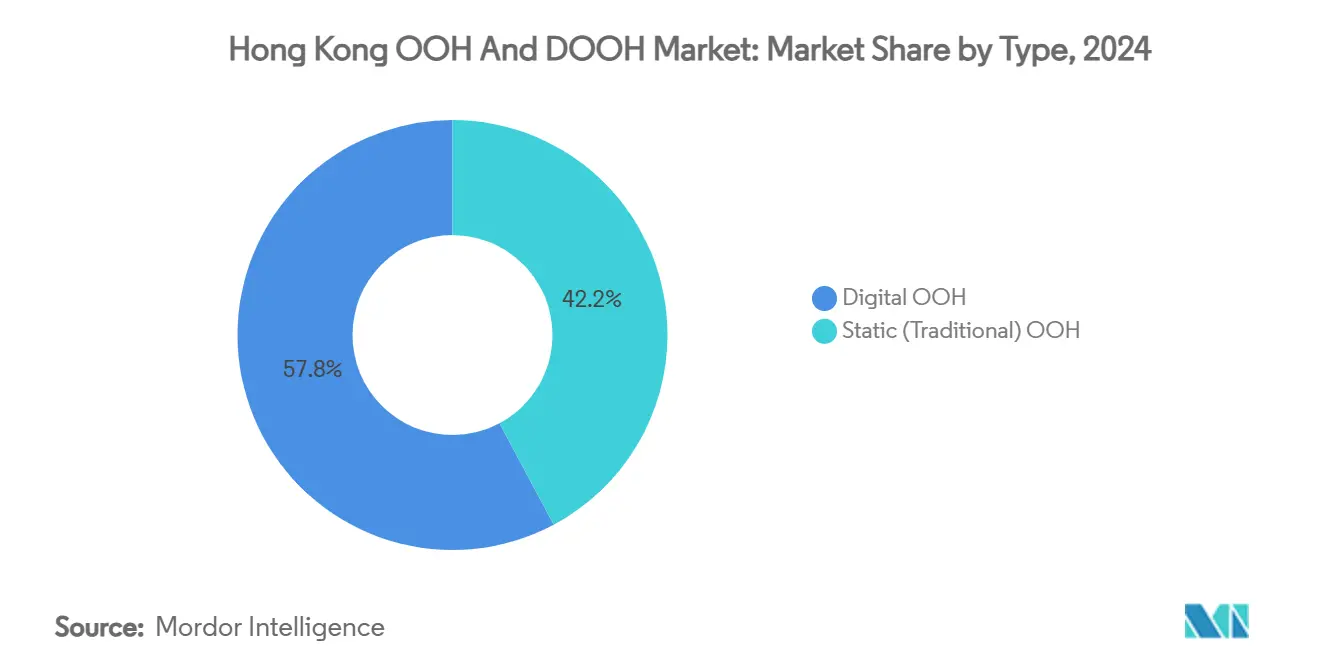
By Format: Transit Environments Capture Mobile Audiences
Transit media accounted for 40.2% of 2024 spend, a dominant block of the Hong Kong OOH and DOOH advertising market. Airport Express lightboxes, MTR platform screens and bus interior LCDs deliver unavoidable exposure during daily commutes. Hong Kong International Airport’s media inventory alone is projected to climb 8.1% CAGR through 2030 as new Terminal 2 gates open and duty-free retail rebounds. Screen adjacency to flight-status boards lifts dwell by 32 seconds versus conventional scrolling LEDs, according to Asiaray’s 2024 passenger study.
Billboards retain cultural cachet along Victoria Harbour, yet new site approvals on Hong Kong Island fell 14% in 2024 because of height constraints. Street furniture, upgraded with 5G small cells, is absorbing demand; its uptime now exceeds 99.5% due to remote diagnostics. Place-based media inside malls, office lobbies, and cinemas is flourishing thanks to retail-as-media initiatives. LANDMARK’s Maison atriums grant brands full audio rights alongside 360-degree LED wraps, commanding USD 110,000 weekly packages for prestige launches. The format diversification gives planners room to orchestrate multi-touch journeys spanning arrival halls to shopping podiums.
By Location Environment: Indoor Growth Outpaces Outdoor Constraints
Outdoor screens still attract 72.5% of budgets, but indoor environments are sprinting faster at a 6.9% CAGR, reflecting fewer regulatory hurdles and weather-proof operating conditions. Indoor loops at Link REIT’s malls reach 560 million shopper impressions yearly, delivering consistent shadow-free visibility that outdoor units cannot match during typhoon season. Advertisers using indoor DOOH report 14% higher recall scores, per JCDecaux’s 2024 brand-lift study, attributed to controlled lighting and climatised ambience increasing viewing comfort.
The global pivot toward indoor DOOH is mirrored locally: Dolphin Digital forecasts the format to leap from USD 19.4 billion in 2023 to USD 49.8 billion worldwide by 2032. Hong Kong landlords integrate proximity beacons so that an on-screen QR triggers coupon pushes to travelers’ WeChat wallets, marrying physical sightlines with mobile conversion. As outdoor site inventory plateaus, media owners are repurposing underutilised mezzanines and corridor walls as digital canvases, adding capacity without incurring new planning approvals.
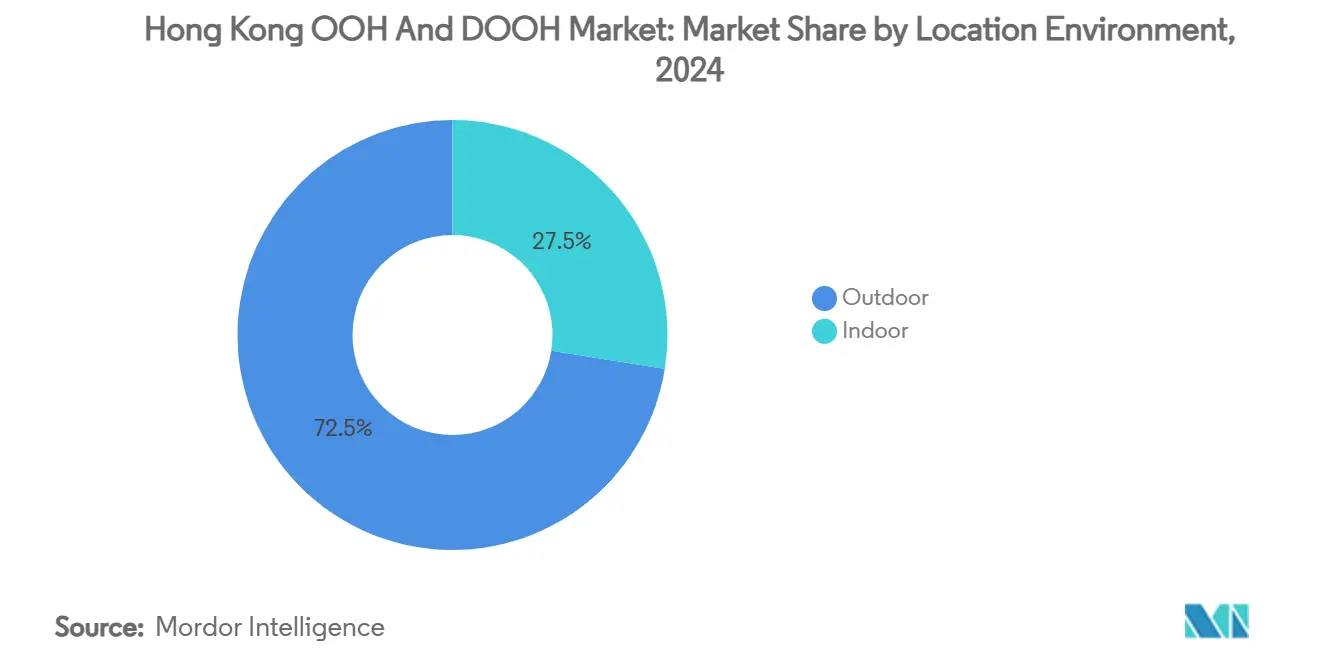
By End-User Industry: Retail Leads While Healthcare Accelerates
Retail and consumer goods brands shaped 30.4% of total billings in 2024, using DOOH to nudge conversion at street-to-store moments. High-luxury houses dominate facade wraps facing Central’s Landmark Atrium, where screen brightness rules permit richer colour gamut. Duty-free skincare brands allocate 11% of Hong Kong OOH and DOOH advertising market spend to animated product demos on Airport Express concourse LEDs, capitalising on inbound beauty shoppers.
Healthcare and pharmaceuticals, though smaller in absolute terms, are accelerating at an 8.5% CAGR. The Hospital Authority’s 2025 e-Health rollout normalises tele-consultation, prompting providers to advertise digital health apps on MTR in-carriage LCDs. BFSI advertisers maintain a robust presence around Central and Quarry Bay, deploying finance-themed creative timed to after-work commuter flows. Government campaigns multiplied in 2024 following the Safeguarding National Security legislation, with civic-education videos looping across 4,000 bus rear panels. Automotive ads cluster in West Kowloon’s high-income precincts, showcasing EV models on full-motion screens near Tesla’s Jordan showroom, a placement that underlines DOOH’s role as a last-mile influence during test-drive journeys.
Geography Analysis
Central’s Grade-A buildings host the costliest OOH real estate in Asia, and the district funnels 29% of the Hong Kong OOH and DOOH advertising market. The USD 1 billion LANDMARK overhaul underpins premium CPM escalation, with full-atrium takeovers booked one year ahead by maison fragrance labels. Height restrictions, however, freeze supply at 2018 levels, prompting landlords to retrofit interior atria with ultra-thin LED fins that qualify as indoor placements while still visible through glass curtainwalls.
Across the harbour, Tsim Sha Tsui benefits from 46 million expected tourist arrivals in 2024. Ocean-facing Avenue of Stars lightboxes crest at 95% occupancy, fuelled by mainland visitors who photograph skyline backdrops. Yet per-capita tourist spend is sliding to HKD 5,800 in 2024, demanding sharper targeting of high-value micro-segments. Media planners are relocating 18% of budgets northward into Kowloon East and Kai Tak, where cruise-ship berths and arts venues create fresh visitor clusters. Mong Kok’s traditional neon alleys face renewal: landlords replace aged tubes with high-density RGB panels to meet EPD energy codes while preserving cultural aesthetics.
The New Territories represent the next growth frontier as MTR’s Northern Link stitches together Tuen Ma Line and Lok Ma Chau Spur Line. Construction starts in 2025 will trigger mixed-use TOD hubs, each planned with integrated digital media corridors from day one. Large-format footprints around Sheung Shui and Kwu Tong are already being pre-sold under five-year bundled contracts, positioning advertisers to capture early mover eyeballs once stations open. This suburban swing diversifies reach beyond traditional harborfront grids and spreads inventory risk amid island-side regulatory rigidity. Overall, 13 unionised commuter nodes in the New Territories are forecast to generate a combined USD 65 million in incremental DOOH spend by 2030, lifting hinterland contribution from 9% to 14% of market total.
Competitive Landscape
JCDecaux SE leads the Hong Kong OOH and DOOH advertising market, leveraging exclusive Airport Express and MTR concourse rights plus a proprietary programmatic stack. Its DOOH revenue advanced 28.3% YoY in H1 2024, and VIOOH now pipes inventory to 42 DSPs globally, enhancing fill rates on under-utilised late-night loops. Asiaray Media Group commands a strong share in transit shelters, bundling cross-border Shenzhen airport media to attract regional campaigns. POAD focuses on luxury retail corridors, controlling over 60 premium facade wraps along Canton Road. Together, these three groups transact just above 45% of gross media value, leaving mid-tier local specialists to service fragmented building skins.
Technological convergence is redrawing the playing field. T-Mobile’s USD 600 million acquisition of Vistar Media, closing Q1 2025, aims to weld telecom data to DOOH audiences, a move likely to introduce US-style deterministic measurement to Hong Kong buys Vistar. Media owners without a robust data stack risk losing share as agency trading desks demand unified IDs across mobile, CTV, and out-of-home. Meanwhile, exchange integrations - such as Eyeota’s September 2024 tie-up with Vistar - unlock third-party persona layers, boosting CPMs for scarce tourist segments.
Barriers to entry remain substantial: exclusive landlord agreements, minimum capital outlays for 4K LED retrofits, and compliance know-how on signage ordinances. Start-ups typically partner with property-tech aggregators to gain fast access to lift lobbies or car-park screens. Opportunities persist in measurement: no provider yet offers city-wide impression-validated currencies akin to US Geopath ratings. Vendors able to deliver trusted reach metrics stand to siphon spend from digital-video budgets by proving incremental, rather than overlapping, audiences.
Hong Kong OOH And DOOH Industry Leaders
-
JCDecaux SE
-
Asiaray Media Group Ltd.
-
POADmedia Ltd.
-
Clear Channel Outdoor (HK)
-
Cody Outdoor International (HK) Ltd.
- *Disclaimer: Major Players sorted in no particular order
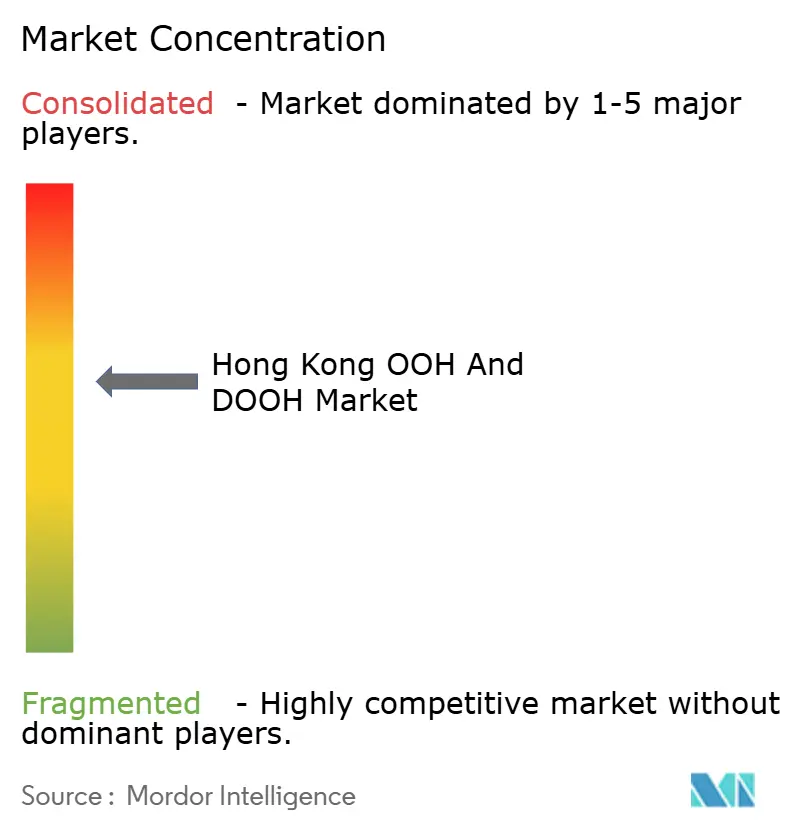
Recent Industry Developments
- February 2025: Hitachi Rail deployed 5G digital signaling on Hong Kong International Airport’s APM, enabling live passenger analytics for DOOH campaigns.
- February 2025: T-Mobile agreed to acquire Vistar Media for USD 600 million to fuse telecom data with programmatic DOOH.
- February 2025: Hongkong Land unveiled a USD 1 billion overhaul of LANDMARK that embeds ten multi-storey Maison zones and expansive LEDs, expanding premium advertising inventory in Central. The refurbishment elevates competition for ultra-affluent shoppers.
- December 2024: Vistar Media expanded its Asia-Pacific staff by 50 % and added 139,000 venues to its supply-side platform, broadening trading opportunities for Hong Kong buyers.
Research Methodology Framework and Report Scope
Market Definitions and Key Coverage
Our study defines the Hong Kong out-of-home and digital out-of-home advertising market as every paid message displayed on static street furniture, large-format billboards, transit interiors or exteriors, and networked digital screens that target audiences while they are outside their homes. This includes programmatic DOOH impressions booked through supply-side platforms but excludes production revenues and agency fees. According to Mordor Intelligence, value is tracked in gross media owner revenue before rebates.
Scope Exclusions: Cinema preshow rolls, in-store point-of-purchase screens, and mobile push alerts are not counted.
Segmentation Overview
- By Type
- Static (Traditional) OOH
- Digital OOH
- Programmatic DOOH
- By Format
- Billboard
- Street Furniture
- Transit
- Airports
- MTR / Bus / Ferry
- Place-Based Media
- By Location Environment
- Indoor
- Outdoor
- By End-User Industry
- Retail and Consumer Goods
- Automotive
- Financial Services (BFSI)
- Healthcare and Pharma
- Government and Public Sector
- Others
Detailed Research Methodology and Data Validation
Primary Research
Mordor analysts interviewed media-owner executives, programmatic platform managers, outdoor media buyers, and brand marketers across Central, Kowloon, and the New Territories. These conversations validated screen fill rates, average CPM shifts, and likely concession renewals, closing data gaps that secondary material could not bridge.
Desk Research
We begin with openly available benchmarks from the Hong Kong Census & Statistics Department, the Transport Department's daily passenger counts, Airport Authority traffic releases, and Tourism Board arrival dashboards, which together portray the moving audience pool. Adspend share data from admanGo, media rate cards in leading dailies, and press releases issued by MTR, Citybus, and the Highways Department further anchor location inventories and unit costs. To refine digital saturation and pricing, our analysts access D&B Hoovers for operator financials, Dow Jones Factiva for contract announcements, and Questel for display-technology patent activity. Additional signals flow from industry associations such as the World Out of Home Organization and the Interactive Advertising Bureau. The sources listed illustrate the breadth of inputs and are not exhaustive.
Market-Sizing & Forecasting
A top-down build that converts audience exposure opportunities into estimated revenue forms the spine of our model, while selective bottom-up operator roll-ups act as a reasonableness cross-check. Key variables include average daily footfall by corridor, share of digital panels in total faces, effective CPM trends, foreign-visitor mix, screen utilization, and Hong Kong dollar to U.S. dollar exchange expectations. Five-year projections use multivariate regression combining GDP growth, inbound tourism, and panel digitization ratios; ARIMA smoothing guards against one-off event spikes. Any bottom-up gaps, such as privately held venue networks, are imputed using matched averages from disclosed peers.
Data Validation & Update Cycle
Outputs pass variance tests against historical adspend, are peer-reviewed by a second analyst, and loop back to key interviewees when anomalies surface. Reports refresh each year, and we reopen the model sooner if major concession awards or regulatory shifts materially change supply.
Why Our Hong Kong OOH And DOOH Baseline Commands Reliability
Published estimates often diverge because firms mix media owner net and gross values, apply distinct discount assumptions, or freeze currency at different points. We ground every line item in audited traffic data and refreshed rate evidence, limiting reliance on broad regional multipliers.
Key gap drivers include scope mismatches that omit bus-body inventory, varying treatments of programmatic uplift, disparate refresh cadences, and inconsistent HKD-USD conversions.
Benchmark comparison
| Market Size | Anonymized source | Primary gap driver |
|---|---|---|
| USD 635 M (2025) | Mordor Intelligence | - |
| USD 381 M (2024) | Industry Tracker A | Uses adspend share without adjusting for rate-card discounts or cross-media rebates |
| USD 179 M (2023) | Global Audit Firm B | Focuses only on traditional static sites, excludes digital transit and airport screens |
Together, the comparison shows that our disciplined scope definition, annual refresh, and dual-step validation deliver a balanced, transparent baseline that decision-makers can replicate and update with confidence.
Key Questions Answered in the Report
What is the current value of the Hong Kong OOH and DOOH advertising market?
The Hong Kong OOH and DOOH advertising market stands at USD 635.05 million in 2025 and is projected to hit USD 848.61 million by 2030.
Which segment is growing fastest in the Hong Kong OOH and DOOH advertising market?
Programmatic DOOH is the quickest-growing pocket, with a 9.2% CAGR forecast through 2030, driven by automated buying and richer audience data.
How important are transit formats within the Hong Kong OOH and DOOH advertising market?
Transit formats hold a 40.2% revenue share in 2024, and airport media specifically is forecast to grow at 8.1% CAGR as international travel rebounds.
What regulatory factors constrain outdoor billboard expansion on Hong Kong Island?
Height caps, heritage-site buffer zones and strict visual-corridor protection create artificial scarcity for new large-format sites in Central, Wan Chai and Sheung Wan.
Page last updated on:
